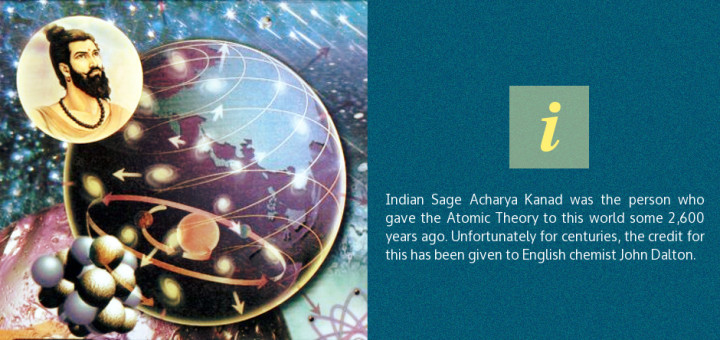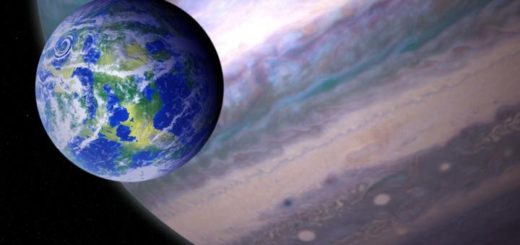The Atomic Theory Was Developed 2,600 Years Ago By An Ancient Hindu Sage

Is history as we know wrong? Despite the fact that John Dalton, an English Chemist, and physicist is credited with developing the atom theory, the truth may be more surprising than you could imagine.
If we take a look at historic records, some 2,600 years before Dalton, an ancient Hindu sage, and philosopher called Kashyap, developed it.
Born in 600 BC, near Dwarka, Kashyap is the actual father of the Atomic theory.
People called him ‘Kanad,’ as ‘Kan’ which in ancient Sanskrit is translated to ‘the smallest particle’ after he was seen gathering grains from the street while on a pilgrimage to Prayag.
Kashyap was fascinated by small particles and began collecting them.
When asked why he was accumulating them he responded that while individual grains might appear as useless or worthless, a collection of hundreds of grains could make someone’s daily meal. He explained how a selection of meals could feed a family and ultimately all of humankind, demonstrating how the smallest grains mattered more than anyone could imagine.
Kashyap was fascinated with the world around him and started writing down his views on everything that surrounded him, and eventually conceptualized the idea of ‘the smallest particle’ that constitutes everything we see and don’t see.
Kashyap passed his knowledge onto others, and people then started referring to him as ‘Acharya,’ the teacher.
Eventually, he became known by the name of Acharya Kanad or ‘the teacher of small particles.’
“Every object of creation is made of atoms which in turn connect with each other to form molecules,” –Kanad.
The more you read about Kanad, the more fascinated you will become with his life and work.
The story behind how he imagined the idea of a particle that could not be divided any further is remarkably compelling.
One day, he was walking with food in his hand, and started breaking it into smaller and smaller pieces until he realized he could not break down the food any further because it was too small It was then when Acharya Kanada described the ‘invisible matter as Paramnu or Anu which translated means ‘atom.’
Acharya Kanad explained how invisible matter could not be sensed through any human organ, nor can it be seen by the naked eye.
Acharya Kanadstated that an inherent urge made one Anu (atom) combine with another.
Acharya Kanad further explained that when two Anu which belonged to the same ‘class’ of substance were combined, a dwinuka or binary molecule was created.
The Ancient Hindu Saga theorized that different mixtures of Anu produced very different types of substances.
It was Kanad who also put forward the idea that anu (atoms) could be combined in several different ways which would produce chemical changes in the presence of other factors like heat.
To provide a more uncomplicated explanation, Kanad gave the blackening of earthen pot and ripening of fruit as an example.
Kanad was also the founder of the Vaisheshika School of philosophy, a place where he shared his ideas, knowledge and explained his theories about atoms, the nature of the cosmos, and all that surrounds us, both visible and invisible.
He also wrote a book titled “Vaisheshik Darshan” where he presented all of his research.
In regards to Kanad, his ideas, theories and discoveries, A.L. Basham, a veteran Australian Indologist asserted that Kanad’s teachings “were brilliant, imaginative explanations of the physical structure of the world, and in large measure, agreed with the findings of modern physics.”
However, Acharya Kanad wasn’t the only source of superior knowledge from ancient India.
According to observations by one of the most prominent Indian scientists, certain ‘slokas’ aka verses of the holy Vedas texts make mention of several undiscovered natural phenomena that were discovered by Westerners many centuries later.
Madhavan Nair stressed that the Vedas, or also known as the four sacred texts of one of the oldest missing Vedic religion, described the presence of water on the moon, the gravitational force, and other scientific phenomena there were not supposed to be known of until centuries later.
The Vedas hold an incredible wealth of information in the field of space and atomic energy.
We were on the right track until the year 600 BC, before the invasions said 71-year-old Padma Vibhushan awardee who believes the Vedas are a treasure trove of knowledge, comprising information on metallurgy, algebra, astronomy, math, architecture, and astrology among other things.
According to the former head of the Indian space agency, the Chandrayaan 1 satellite, orbited around the moon thanks to an equation expressed thousands of years ago by Aryabhata.
Source and reference
Image credit
“Every object of creation is made of atoms which in turn connect with each other to form molecules,” –Kanad.



 Creators of mankind
Creators of mankind Description of “Tall white aliens”
Description of “Tall white aliens” Where they came from?
Where they came from? About hostile civilizations
About hostile civilizations The war for the Earth
The war for the Earth “Tall white aliens” about eternal life
“Tall white aliens” about eternal life Video: “Nordic aliens”
Video: “Nordic aliens” Aliens
Aliens Alien encounters
Alien encounters The aliens base
The aliens base UFO
UFO Technology UFO
Technology UFO Underground civilization
Underground civilization Ancient alien artifacts
Ancient alien artifacts Military and UFO
Military and UFO Mysteries and hypotheses
Mysteries and hypotheses Scientific facts
Scientific facts


















